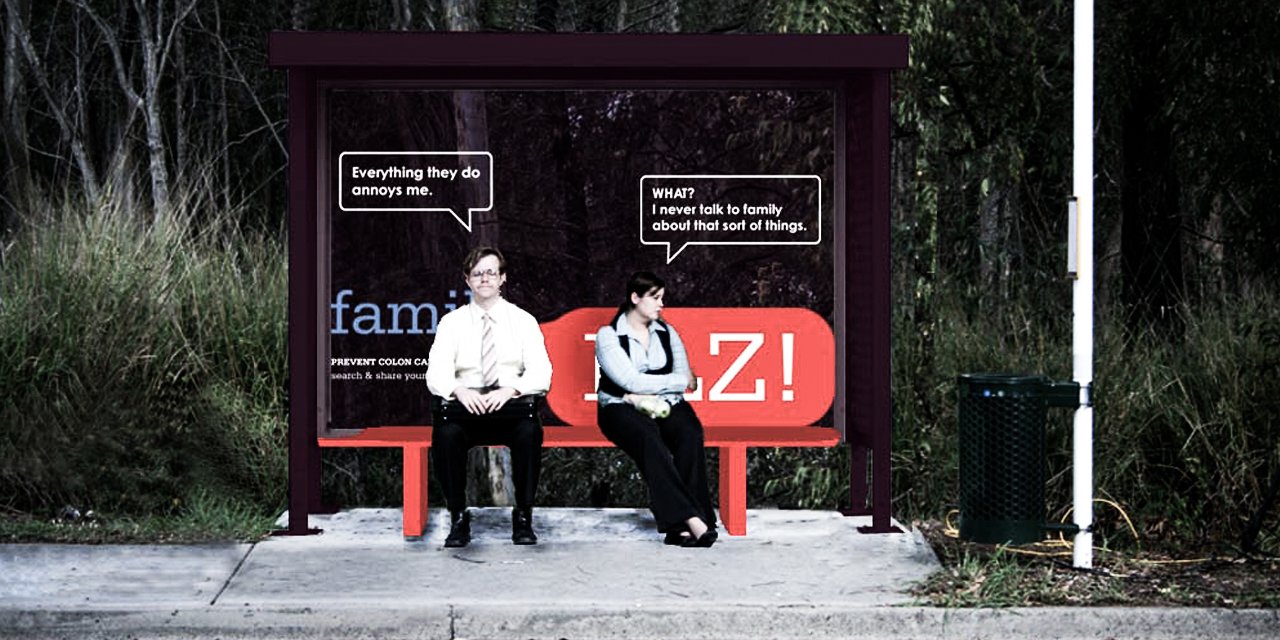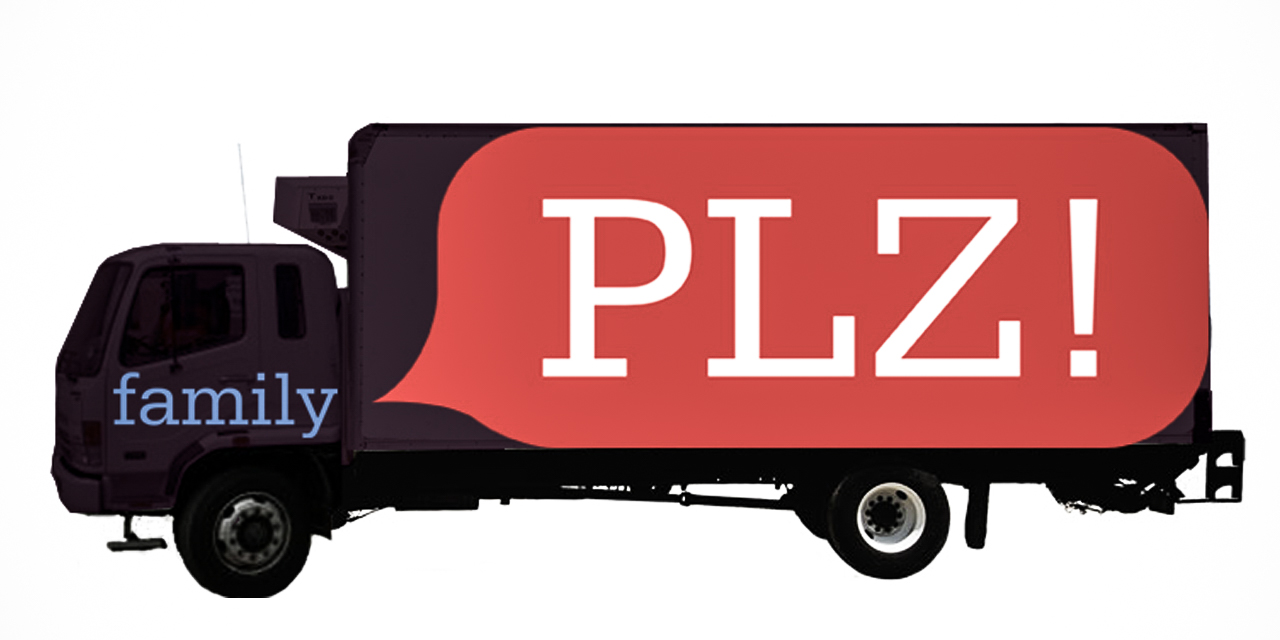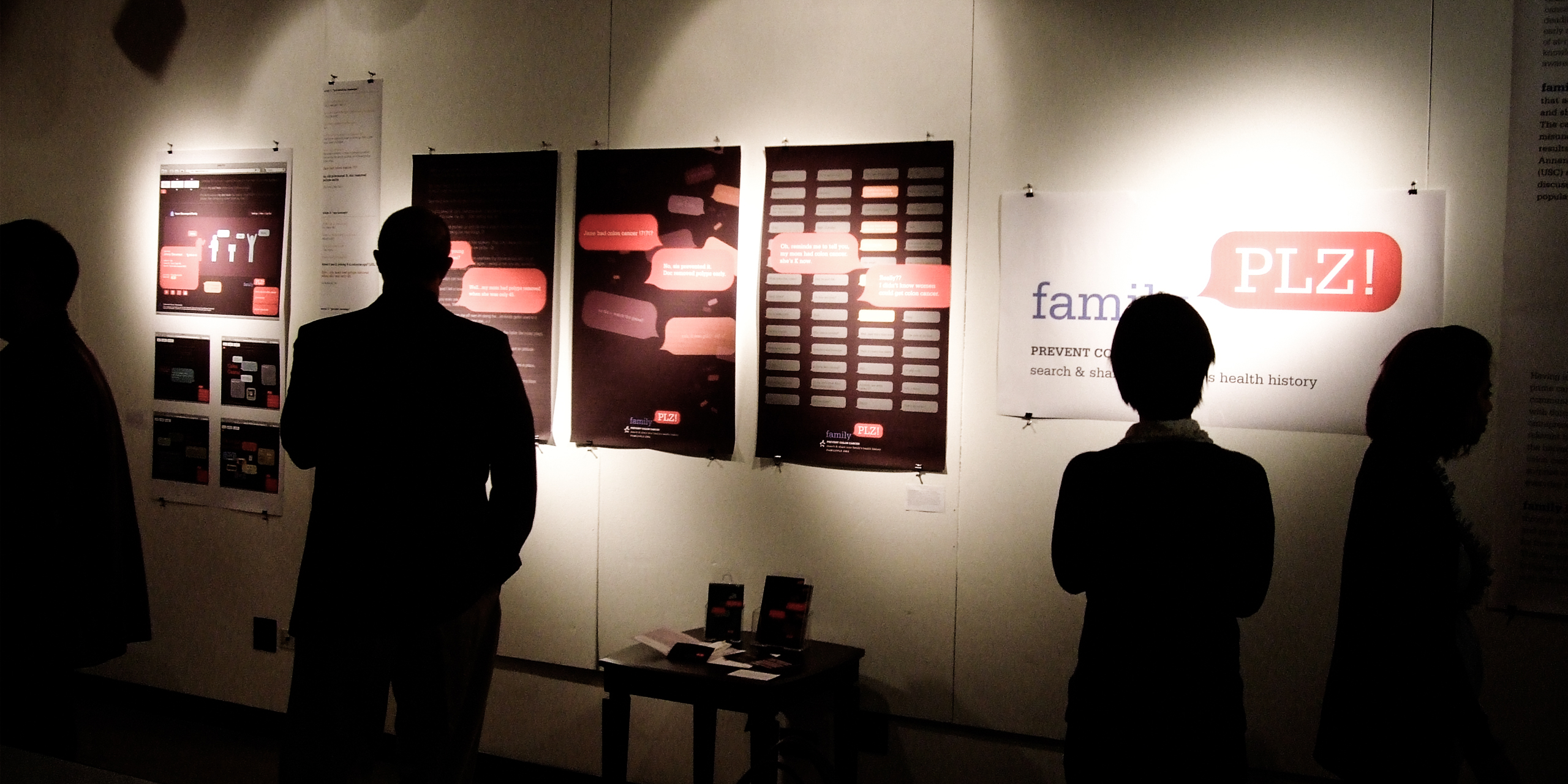FamilyPlz! Cancer Prevention Campaign
- Global Health

Fall 2009
Mixed Media Campaign to Promote Colorectal Cancer Screening in collaboration with the Mayo Clinic/Innovation Unit and The American Cancer Society.
The most compelling part of this experience for me was learning how to affect people in a positive way. The challenge was to spur people to take action, and this isn’t an easy thing to do in a time when we are bombarded with imagery. It was an amazing experience to really begin to understand the power of design as a vital communication tool.
-Christina Nizar, Student, Graphic Design

Design Brief
Design Brief
According to the CDC (Center for Disease Control), among cancers that affect both men and women, colorectal cancer is the second leading cause of cancer-related deaths in the United States. Colorectal cancer screening (CRC) is effective and cost-efficient, yet it remains underutilized by the general population. Incomplete (or absent) awareness of colorectal cancer risk continues to be a major barrier. Novel communications approaches are needed to emphasize the importance of past medical history, family history, diet, lifestyle, etc., so that screening services can be provided, and personalized, to individuals who are most likely to benefit.
The goal of this project is to test the potential of a user-centered, mixed media CRC screening education and awareness campaign to encourage people, especially younger populations who may be at risk, to act in overcoming practical barriers to screening.
Art Center students and faculty worked with the Innovation Unit at the Mayo Clinic and the American Cancer Society to design a viral campaign using social networks (Twitter, Facebook, etc.) and build a contemporary message of awareness around colorectal cancer.
The primary audience for this campaign are men and women between the ages of 20 and 40 years old who are not typically aware of the need for colorectal cancer screening, who have a family history of colorectal cancer and who have never been screened.
The potential impact for pursuing a user-centered, innovative mixed media approach is to maximize how people are already using new technologies for communication and community building in a way that creates movement beyond awareness to direct action. It is also an opportunity to translate awareness into action clinically – and to track and measure direct results. Specific Objectives include:
– Promote family history as a key factor in the need for colorectal cancer screening;
– Create a message that will resonate with a younger audience and support evidence-based colorectal cancer education and awareness; – Incorporate the Blue Star (where deemed applicable) to magnify and unify the screening message;
– Identify benchmarks to measure progress towards goal, e.g. increase media coverage of CRC screening, increase in CRC awareness and education and increase CRC screening;
– Track and measure direct campaign impact. A post-collaboration performance assessment will be based on measures agreed upon by the collaborators at the beginning of the project. Creative campaign performance and outcome measures will be assessed via a national tracking survey and semi-structured interviews with both the public and physicians at Mayo Clinic and affiliated sites. Measurement and survey specialists at Mayo Clinic will be consulted prior to implementation.

The “Family plz!” campaign is a complete media ecosystem that introduces, encourages, provokes and humors people into finding out and sharing their family’s colorectal health history. The students’ efforts to navigate the many pitfalls inherent to the topic were aided tremendously by the (sometimes surprising) research findings from the Annenberg School of Communication. The result was a precisely balanced, accurate and charming cross-media campaign that can help save lives.
-Allison Goodman, Faculty, Graphic Design

Research and Project Development
The faculty guided the students through a participatory, human‐centered approach to the research (which benefited from focus testing results also overseen by Dr. Sheila Murphy from USC Annenberg) in order to develop an integrated campaign with materials and communication interventions that would focus on the realities of everyday life for the target audiences in question. Primary to this research phase for the team was identifying the relationships between behaviors, the material and built environments, and use and influence of relevant communications media and storytelling networks.
Outcomes
The “big idea” of the communication behind the “Family PLZ!” campaign is to promote, through contemporary media channels and social networks, family history as a key factor in the need for colorectal cancer screening. To that end, the student teams devised an integrated system of messaging that is envisioned to take on Web, print and environmental applications in the forthcoming stages of implementation of the campaign by project partners. Prior to arriving at the conceptual framework of this system, the student and faculty team iterated a number of potential paths that the campaign could follow. Early concepts studied the impact of humor as a means to create a large societal dialogue around CRC, as well as the adoption of special characters and gaming to encourage health communication. The teams worked to develop a campaign that adopts the Internet vernacular across several media to explore how we might empower families to have important conversations about their health, and in turn have those conversations drive heightened awareness about colorectal cancer, screening and prevention.
In December of 2011, the project was launched with www.familyPLZ.org. Along with information about colorectal cancer, the site also features animated videos, downloadable promotional materials as well as links to familyPLZ branded groups onTwitter, Youtube and Facebook.

This campaign should address why people have a hard time putting together a family history, how we might be able to help them make sense of the information they do have, and how to help them gather information that is not likely to come up in the average family conversation.
-Maggie Breslin, Senior Designer and Researcher, Mayo Clinic Center for Innovation
Press Release
-

-
FamilyPlz! Cancer Prevention Campaign (FA09)
Download PDF
All work shown here, including Project Gallery images, is ©2009 Mayo Foundation for Medical Education and Research and American Cancer Society, Inc. All rights reserved.